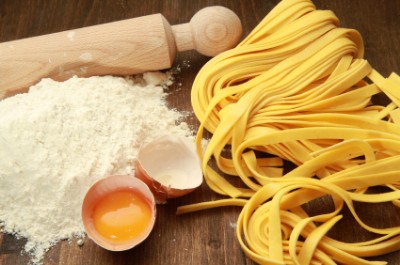Our basic recipe for the pasta dough is about 1 egg to every 3/4 cup of flour. Of course, this will vary on how big the egg is, how fresh, and what kind of flour using. So it’s just a starting point. Add just a little water to the dough if I think it’s too dry. If you would like a richer pasta for a special occasion, add more egg yolks to the dough.
When we make fresh pasta, making it for 2 or 3 people, you can make the dough by hand. Just mound the flour on your counter, create a well in the middle and break your eggs into it. Whisk the eggs with a fork and start incorporating the flour until it has all been added. A pastry scraper makes this process a lot easier, allowing you to scrape up the dough. If you have a regular sized stand mixer, you can make the dough in that, if you prefer. Add the eggs into the bowl and mix them with the dough hook a little – and then start adding your flour until it mixes up into a nice dough. If you have a larger batch of pasta dough to make, I always make it in my KitchenAid mixer.
Making flavored pastas is easy, too. The tomato pasta above just has a little bit of tomato paste added to the dough. That’s it. For spinach pasta, it’s better to make the dough in a food processor because it blends the spinach a little better than by hand (although you can certainly do it by hand – just chop the spinach very finely before adding it to the dough). There are all kinds of flavors you can add to pasta once you master the basic plain pasta – peppered pasta, beet pasta, saffron pasta, herb pasta, and on and on. If you make flavored pastas that use moist or wet ingredients like tomato paste or spinach, you will need to add a bit more flour until you get a dough that is not too sticky.
After you make the dough, it must rest a little. Wrap the dough in a piece of floured plastic wrap and let it sit at room temperature for about 20 to 30 minutes. It will be easier to roll out.
here are different ways to roll out the dough and I prefer, of course, the easiest method – my KitchenAid pasta rollers, which you can see in action in the video. I used an Atlas hand crank machine many years ago, and that is absolutely fine but if you have a stand mixer, get the pasta rollers and cutters attachment and you will be making pasta even faster. The machine simply cranks the rollers for you, which lets you have an extra hand. The most difficult way to roll out the dough is by hand with a rolling pin. If you want to do that, it is a technique that takes a lot more effort but you may find it satisfying. I prefer the machine.
Rolling out the pasta is not hard – you will get the hang of it pretty quickly. After the pasta has rested, cut off a piece about the size of the palm of your hand. Adjust the pasta rollers to #1, the widest setting, and put the pasta through. Make sure you flour the pasta dough lightly so that it doesn’t stick to the rollers. After the dough comes through the rollers, fold it into thirds and pass it through the #1 slot again. Do this a couple of more times. The pasta will become very soft and velvety. Adjust the rollers to the next thinnest setting, #2, and put the pasta through. Do not fold the pasta this time. Keep passing it through the rollers, adjusting them thinner, until you reach the thickness you like. We usually stop at #5 or #6 (for ravioli, never go beyond #5 because it will be too thin). As you pass the pasta through narrower settings, the pasta may become sticky again – keep lightly flouring it.
At this point, you now have fresh pasta sheets that you can make homemade lasagna with. After rolling out the pasta sheets, they must dry just a little on the counter if you want to make a cut pasta, like linguini or fettuccine. If you cut them before they have dried a little, the cutters will not cut them cleanly through. Dry them too much, however, and they will be brittle.
This recipe (1 egg + 3/4 cup flour) produces about 5 to 6 ounces of fresh pasta. It is easily doubled, tripled, etc.
To cook the pasta, boil it for only about two minutes in a large pot of salted water.
Never wash your pasta rollers – this will ruin them. Just wipe with a paper towel. If you feel you need to wash them because there are bits of dough stuck to them, then your dough was too wet. Remember to keep your dough lightly floured and it will not stick to your rollers or cutters.


